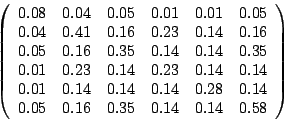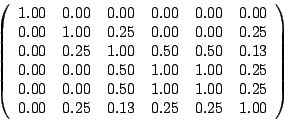1. INTRODUCTION
Finding similar web pages to a query page is a
crucial task for a search engine. Recently, a variety of
link-based similarity measures, which use only the hyperlinks in
the Web, have been proposed for this task. This includes
companion algorithm [3],
cocitation algorithm [3], and
SimRank [4], etc.
In this paper, we propose a novel link-based similarity
measure, called PageSim. Contrast to SimRank, our method can
measure similarity between any two web pages, whereas SimRank
cannot in some cases.
SimRank is a fixed point of the recursive definition: two
pages are similar if they are linked to by similar pages.
Numerically, for any web page  and
and
 , this is specified by defining
, this is specified by defining
 and
and
 |
(1) |
for  and
and
 , where
, where
 denotes the set of inlink
pages of
denotes the set of inlink
pages of  ,
,  denotes the cardinality of the set. If
denotes the cardinality of the set. If
 or
or  is empty, then
is empty, then  is zero by definition. The SimRank iteration
starts with
is zero by definition. The SimRank iteration
starts with
 for
for  and
and
 for
for  . The SimRank score
between
. The SimRank score
between  and
and  is defined as
is defined as
 .
.
Unfortunately, the result of SimRank is not convincing in some
cases. In one case, if one of two web pages has no inlink, then
the SimRank score of them is zero by definition, which means they
are not similar. However, this is not always true. For example,
in Figure 1
of section 4,  has no inlink, but it is
clear that both
has no inlink, but it is
clear that both  and
and
 have some similarity with it
for they are linked to by
have some similarity with it
for they are linked to by  . In
another case (also in Figure 1), SimRank
concludes that
. In
another case (also in Figure 1), SimRank
concludes that  and
and  are not similar. In fact, obviously
are not similar. In fact, obviously  and
and  indeed have some similarity, for they link to each
other.
indeed have some similarity, for they link to each
other.
2. PAGESIM
PageSim can be considered as an extension of cocitation
algorithm, in which the similarity score between two web pages is
defined by the number of inlink neighbors that they have in
common. Actually, on the Web, not all links are equally
important. For example, if the only common neighbor of page
 and
and  is the Yahoo home page [1],
whereas page
is the Yahoo home page [1],
whereas page  and
and  have several common neighbors from obscure places,
then which page is more similar to page
have several common neighbors from obscure places,
then which page is more similar to page  , page
, page  or page
or page  ? As we know, hyperlink from web page u to
v can be considered as a recommendation of page v
by page u [2], and the
more important a web page is, the more important its
recommendation is. Evidently, the reasonable answer should be
page
? As we know, hyperlink from web page u to
v can be considered as a recommendation of page v
by page u [2], and the
more important a web page is, the more important its
recommendation is. Evidently, the reasonable answer should be
page  , since the Yahoo home page is
much more ``important". In another perspective, the action of
recommendation can be considered that page u
propagates some kind of similarity to page v, and
the more pages it links to, the less similarity it should
propagate to each of these pages. Therefore, it is also
reasonable to think that the Yahoo home page has some kind of
similarity with both page
, since the Yahoo home page is
much more ``important". In another perspective, the action of
recommendation can be considered that page u
propagates some kind of similarity to page v, and
the more pages it links to, the less similarity it should
propagate to each of these pages. Therefore, it is also
reasonable to think that the Yahoo home page has some kind of
similarity with both page  and page
and page
 .
.
Since PageRank [5] is one
of the most prominent ranking algorithm which assigns global
ranking scores to all pages on the Web, we take the PageRank
score of a web page as the importance (weight or
similarity score) of it in the PageSim method. The
intuitions to PageSim model is described as follows, and the
mathematical definitions will be given later.
At the beginning, each web page only contains its own
similarity score, and then each web page propagates its own
similarity score to its outlink neighbors, receiving and
propagating the similarity scores of others at the same time.
After the propagation, each page contains its own similarity
score as well as the similarity scores of others. These scores
are stored in a vector called the similarity vector of
this page. Then we can calculate the PageSim score of each
pair of pages by summing their common similarity scores
up.
3. DEFINITIONS
We model the Web as a directed graph  with vertices
with vertices  representing web pages
representing web pages
 and directed
edges
and directed
edges  representing hyperlinks between
web pages. Let
representing hyperlinks between
web pages. Let  and
and  denote the set of inlink pages and
outlink pages of
denote the set of inlink pages and
outlink pages of  respectively, for any
respectively, for any  . Let
. Let
 denotes a sequence
of vertices
denotes a sequence
of vertices
 such that
such that

 and
and
 are distinct, it is called a
path from
are distinct, it is called a
path from  to
to  . Let
. Let  denotes the length of path
denotes the length of path  , define
, define
 . Let
. Let
 denotes the set of all
possible paths from page
denotes the set of all
possible paths from page  to
to
 .
.
Definition 1 Let
 denotes the PageRank
score of page
denotes the PageRank
score of page  , for
, for
 . Let
. Let  denotes the PageRank score that page
denotes the PageRank score that page
 propagates to page
propagates to page  through
through  , i.e.,
, i.e.,
 ,
where
,
where  .
.
Definition 2 Let
 denotes
the similarity vector of page
denotes
the similarity vector of page  , we have
, we have
 where
where  . Let
. Let
 denotes the PageSim
score of page
denotes the PageSim
score of page  and
and  ,
,
 ,
where
,
where  .
.
4. PAGESIM VS SIMRANK
A good evaluation of PageSim is difficult without performing
extensive user studies or having a reliable external measure of
similarity to compare against. In this section, we give a simple
example in which PageSim is compared with SimRank to illustrate
the performance of PageSim.
For a given graph  , where
, where
 (see
Figure 1).
Let
(see
Figure 1).
Let
 . We
have
. We
have

The PageSim score matrix is

.
Let  denotes the top
denotes the top
 similar pages to page
similar pages to page
 (excluding
(excluding  ). Let
). Let  , we
have
, we
have
The SimRank score matrix of graph  is
is

.
Thus, we have
Figure 1: graph 
|
|
We can see that the results of PageSim and SimRank are
different. First, SimRank shows that there's no page similar to
 . While PageSim shows that
. While PageSim shows that
 is most similar to
is most similar to
 , which is more reasonable.
Because the fact that
, which is more reasonable.
Because the fact that  links to
links to
 implies
implies  ``considers"
``considers"  has
some level of similarity with it. Secondly, SimRank shows
has
some level of similarity with it. Secondly, SimRank shows
 is not similar to
is not similar to  , while PageSim shows that is
not true. Obviously,
, while PageSim shows that is
not true. Obviously,  and
and
 are similar, for they link
to each other. Moreover, PageSim considers that
are similar, for they link
to each other. Moreover, PageSim considers that  is most similar to
is most similar to
 . SimRank shows
. SimRank shows  is most similar to
is most similar to
 , for they have a common
inlink page
, for they have a common
inlink page  . We believe PageSim is
the winner in this situation because the ``link to each other"
relationship really implies stronger similarity than that of the
``common inlink" relationship.
. We believe PageSim is
the winner in this situation because the ``link to each other"
relationship really implies stronger similarity than that of the
``common inlink" relationship.
This paper introduces PageSim, a novel link-based similarity
measure. Based on the strategy of PageRank score
propagation, PageSim is capable of measuring similarity
between any two web pages.
There are numbers of avenues for future work. Foremost, we
must address the efficiency issue. For example, the computing
time of PageSim is expected to be greatly reduced by limiting the
radius of propagation, i.e., the path length of propagation.
Especially, when the radius is reduced to 1, PageSim becomes a
``weighted cocitation algorithm". Finally, extensive
evaluations of PageSim are needed.
This work
is supported by grants from the Research Grants Councils of the
HKSAR, China (Project No. CUHK4205/04E and Project No.
CUHK4235/04E) and is affiliated with the Microsoft-CUHK Joint
Laboratory for Human-centric Computing & Interface Technologies.
REFERENCES
[1] http://www.yahoo.com.
[2] A. Arasu, J. Cho, H. Garcia-Molina, A. Paepcke, and S. Raghavan. Searching the Web. ACM Transactions on Internet Technology, 1(1):2-43, 2001.
[3] J. Dean and M. R. Henzinger. Finding related pages in the World Wide Web. Computer Networks (Amsterdam, Netherlands: 1999), 31(11-16):1467-1479, 1999.
[4] G. Jeh and J. Widom. SimRank: a measure of structural-context similarity. In KDD '02: Proceedings of the eighth ACM SIGKDD, pages 538-543, New York, NY, USA, 2002. ACM Press.
[5] L. Page, S. Brin, R. Motwani, and T. Winograd. The PageRank citation ranking: bringing order to the Web. Technical report, Stanford Digital Library Technologies Project, 1998.
![]() clustering, search process; G2.2 [Discrete Mathematics]: Graph Theory
clustering, search process; G2.2 [Discrete Mathematics]: Graph Theory
![]() graph algorithms
graph algorithms .
.

 .
.
